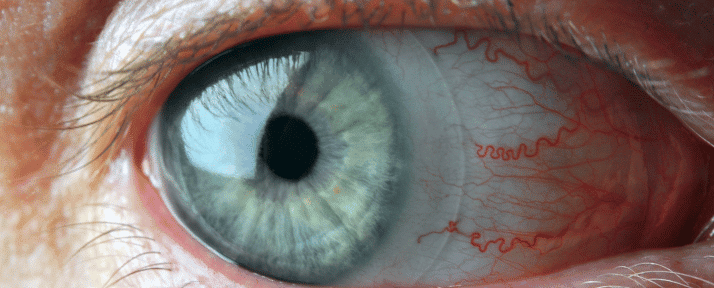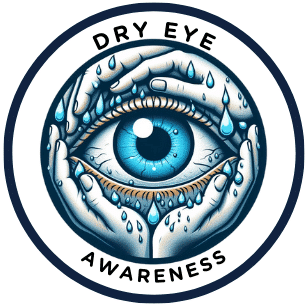
Contact lenses have revolutionized how people correct their vision, providing a convenient and cosmetically appealing alternative to traditional eyeglasses. However, some wearers may experience discomfort and dryness, commonly known as “dry eye,” while wearing contact lenses. Understanding the causes of dry eye and adopting preventive measures and management strategies can ensure a comfortable and enjoyable contact lens experience and prevent dry eye with contact lenses.
Causes of Dry Eye with Contact Lenses
- Reduced Tear Production: Contact lenses can disrupt your natural tear film resulting in insufficient moisture to keep your eyes adequately lubricated.
- Evaporation of Tears: Contact lenses on your eye’s surface can accelerate tear evaporation, causing dryness.
- Lens Material and Design: Some contact lens materials may not retain enough moisture, causing them to draw water from your eyes. Additionally, specific lens designs might interfere with your tear film, leading you to have dry eye with contact lenses.
- Environmental Factors: Air-conditioned or dry environments can exacerbate dry eye symptoms, especially for contact lens wearers.
- Prolonged Wear: Wearing contact lenses for an extended period, significantly beyond the recommended duration, can contribute to dryness and discomfort.
Prevention of Dry Eye
- Proper Lens Selection: Consult with your eye doctor to determine the best contact lens type, material, and design suited for your eyes and lifestyle.
- Regular Replacement: Adhere to the recommended replacement schedule provided by your eye doctor to prevent debris buildup on your lenses, which can contribute to your dry eye with contact lenses.
- Avoiding Smoke and Dust: Minimize exposure to smoke and dust, as they can worsen dry eye symptoms.
- Maintaining Hydration: Stay adequately hydrated by drinking plenty of water, which can help support tear production.
- Blink Regularly: Remind yourself to blink more often while using digital devices or during activities that may cause reduced blinking, such as reading or focusing on screens.
Management of Dry Eye with Contact Lenses
- Artificial Tears: Artificial tears can help lubricate the eyes and alleviate dryness. Following the recommended application frequency, use these drops while wearing contact lenses.
- Reassess Lens Type: If dry eye symptoms persist, consult your eye doctor to reassess the contact lens type, material, or fit.
- Limit Lens Wear Time: If your dry eye symptoms are severe, consider reducing your daily wear time or switching to glasses on days when prolonged lens wear is unnecessary.
- Hygiene and Cleaning: Use proper contact lens hygiene practices to avoid irritation and infections that can exacerbate dry eye symptoms.
- Nutrition: Consuming a diet rich in omega-3 fatty acids and staying mindful of your overall nutrition can positively impact your eye health and tear production.
FAQs (Frequently Asked Questions)
Q1. Can I continue wearing contact lenses if I experience dry eye symptoms?
Yes, you may continue wearing contact lenses with proper management and care. Consult your eye doctor to find solutions to alleviate your dry eye symptoms.
Q2. Are some people more prone to dry eye with contact lenses than others?
Yes, some individuals may be more susceptible to dry eye with contact lenses due to pre-existing dry eye conditions, certain medications, or specific environmental conditions.
Q3. Can I use over-the-counter eye drops while wearing contact lenses?
Yes, you can use artificial tears while wearing contact lenses. However, it is essential to choose drops specifically labeled as safe for contact lens wearers and follow the recommended frequency of application.
Q4. How often should I replace my contact lenses to minimize dry eye symptoms?
Follow the recommendations of your eye doctor, which can depend on the type of contact lenses you wear (daily, weekly, monthly).
Q5. Can I wear contact lenses if I work in front of a computer all day?
Yes, you can wear contact lenses while working on a computer, but remember to follow the 20-20-20 rule: Take a 20-second break every 20 minutes and focus on something at least 20 feet away. Additionally, remember to blink regularly to keep your eyes lubricated.
Conclusion
Experiencing dry eye with contact lenses is a common concern. Still, you can manage your dry eyes with contact lenses with proper understanding and proactive measures. If you encounter persistent or severe dry eye symptoms, consult your eye doctor to find the best solutions that suit your needs, ensuring a comfortable and enjoyable contact lens-wearing experience.
This article should not replace professional advice. Always consult an eye care professional for an accurate diagnosis and appropriate treatment.
